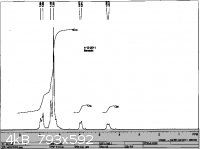Mister Junk Pile
Hazard to Self
 
Posts: 70
Registered: 2-7-2010
Member Is Offline
Mood: No Mood
|
|
NMR Spectra of Benzoin Synth'd Using Thiamine as Catalyst Showing Two Doublets
Maybe this should be in beginnings? You won't see any complaints from me if it's moved.
In class we performed the dimerization of benzaldehyde using thiamine chloride/NaOH as the catalyst. We used a 1:1 DH2O/EtOH mixture to wash with
after vacuum filtration (this perfectly removed the somewhat bright yellow color). The reaction was done in EtOH.
If you need the exact procedure to answer my question please say so and I will cheerfully oblige.
We did a 1H-NMR (200 MHz) using CDCl3 as the solvent and got the following spectrum:

There was one other person who got MUCH better resolution of the doublets than this.
We cannot figure out how we could possibly get the two doublets there. Does anyone have any insight to offer? I would greatly appreciate it.
|
|
|
Nicodem
Super Moderator
      
Posts: 4230
Registered: 28-12-2004
Member Is Offline
Mood: No Mood
|
|
It is perfectly normal to observe couplings with exchangeable protons (CH-OH, in this case). I know it is sometimes thought to
students that exchangeable protons don't couple, but that is not always true (as a student, I was also thought this nonsense). Sometimes they don't,
but often they do. Actually, in my experience they quite commonly do. For example, if you take the 1H NMR of dilute ethanol you will most likely not
observe the <sup>3</sup>J<sub>HH</sub> coupling in the CH<sub>2</sub>-OH group (1
singlet for OH, one triplet for CH<sub>3</sub> and one quartet for CH<sub>2</sub> . But when you take the spectra of a more concentrated sample, it can happen see the CH<sub>2</sub> and OH
coupling (CH<sub>2</sub> should thus be a dq). I'm sure you can find related examples by searching - there must be some pedagogic stuff on
the internet, probably using the same example of ethanol. . But when you take the spectra of a more concentrated sample, it can happen see the CH<sub>2</sub> and OH
coupling (CH<sub>2</sub> should thus be a dq). I'm sure you can find related examples by searching - there must be some pedagogic stuff on
the internet, probably using the same example of ethanol.
…there is a human touch of the cultist “believer” in every theorist that he must struggle against as being
unworthy of the scientist. Some of the greatest men of science have publicly repudiated a theory which earlier they hotly defended. In this lies their
scientific temper, not in the scientific defense of the theory. - Weston La Barre (Ghost Dance, 1972)
Read the The ScienceMadness Guidelines!
|
|
|
Mister Junk Pile
Hazard to Self
 
Posts: 70
Registered: 2-7-2010
Member Is Offline
Mood: No Mood
|
|
Thank you for your quick and accurate reply.
|
|
|